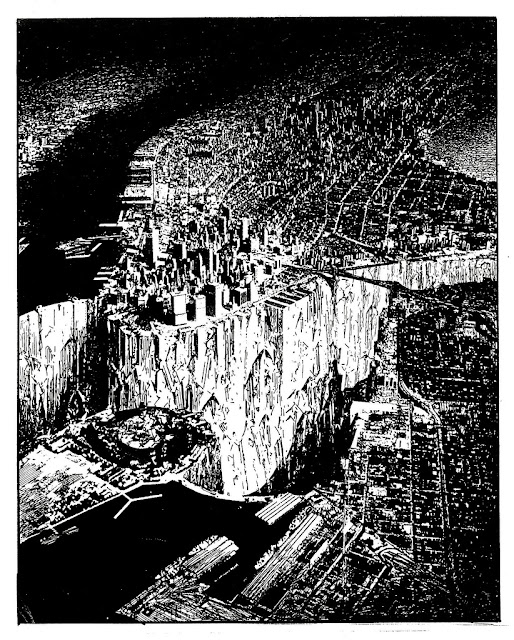From the Chiasmus Archive: "MONUMENTS OF ARCHITECTURE AND CREATORS OF THE TRANSCENDENCE - LEBBEUS WOODS (PART 2)" - July 30, 2019.
Einstein Tomb. Lebbeus Woods (1980)
(All images from Dazeen, MoMa, Wired and associated websites. Used in promotion of the artist.)
Should a city cover its scars and history with prefabricated creations? To veil the organic process of pain and struggle as, to which a city, very much like Lebbeus Woods imaged as a conceptual or more appropriately an experimental architect - heals its self, as does its inhabitants, the scarred and broken configurations, redesigns and coalesces to form other parallel manifestations of structural design. But, in this process of reflection, which Woods, as an experimental architect was able to manifest in intellectual theory of what architecture and design entails. It is within this building and rebuilding of a society, is how it reflects, consciously, on the past and our hopes for a future, in all of its turmoil and at times peacefulness of human nature. Which in turn casts a physical reflection onto the natural systems, that is, however, not conscious of our existence. Woods was no post modern conceptualized architect, rather he knew science, physics and engineering. The curiosity was of what could be melded within nature from human design, constructed as science fiction concepts, while at the same time ensuring possibilities of setting a precedence by attaching science and knowledge to the monuments of structure. In 1980, Woods, inspired by the French architect of the 1700s Étienne-Louis Boullée concept artwork for the cenotaph for Newton, from a period of Enlightenment in Europe and at that time embracing the sciences and its knowledge – devises a tomb for Albert Einstein, the Einstein Tomb, as a monolithic space station, to float along along the electromagnetic currents into the infinity of the cosmos. A statement of human achievement and understanding what Space and Time means to the conscious mind. Woods created a small scaled model of the tomb, an affirmation of respect that embraces the noesis. This is where, in my opinion, he does not restrict himself to social and political aspects of dogma, Woods retains the idealism that structure, when developed within the freedom of experimental concepts transcends away from ideology. It then becomes humanistic and centered as a necessity beyond any form of rhetoric – it is the human experience and our fragility that becomes the paramount for its structural development.
This is his discipline, the refinement of the many drawings, art work and scaled models created before his death in 2012. The facination of what is broken and scarred can be tranfomed. From early conceptualized designs Woods later begins to study warzones, cities effected by disasters and political turmoil. He begins to move beyond the predicaments of dystopia to newer realms.
"The scar is a deeper level of reconstruction that fuses the new and the old, reconciling, coalescing them, without compromising either one in the name of some contextual form of unity. The scar is a mark of pride and of honor, both for what has been lost and what has been gained. It cannot be erased, except by the most cosmetic means. It cannot be elevated beyond what it is, a mutant tissue, the precursor of unpredictable regenerations. To accept the scar is to accept existence. Healing is not an illusory, cosmetic process, but something that -by articulating differences- both deeply divides and joins together."
Lebbeus Woods
___
(A.Glass 2019)







Comments
Post a Comment